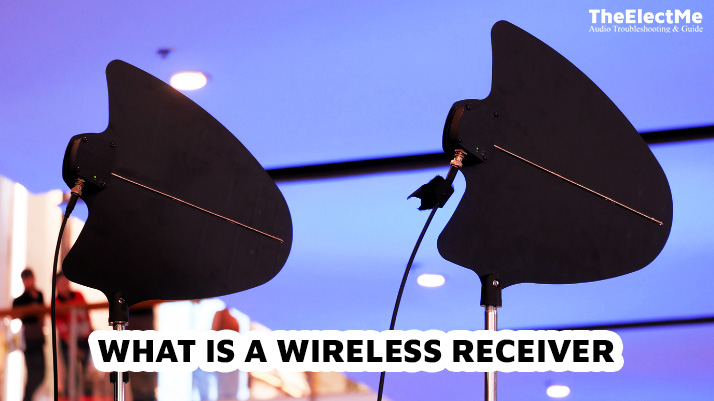What is a wireless receiver? A wireless receiver is a device that obtains and interprets signals sent from a wireless transmitter, such as radio waves, Bluetooth, or WiFi. Its main function is to receive and process these signals.

However, how does the wireless receiver work? In this blog post, you will learn about the different types of wireless receivers and their various applications. Let’s explore the working principles and uses of this essential piece of technology.
What Is A Wireless Receiver, And How Does It Work?
A wireless receiver is an electronic device that converts electromagnetic waves into electrical signals. These signals are amplified and sent to electronic devices like speakers, TVs, or computers. The process of converting electromagnetic waves into electrical signals is known as demodulation.
The working principle of a wireless receiver depends on the type of wireless technology it uses.
The typical principle applies to all who use an antenna that receives signals. After receiving the signals, the receiver uses a tuner to filter and select specific frequencies.
Next, it passes through a demodulator to convert the radio signal into a format electronic devices can understand. How to connect wireless speaker to receiver for better sound quality.
After explaining the principle, let’s move to the types of wireless receivers.
What Are The Different Types Of Wireless Receivers?
Several wireless receivers include radio, Bluetooth, WiFi, and satellite. Each type has its specific use and functionality.
1. Radio Receivers
Radio receivers are used to receive signals from radio stations. They include simple devices like AM/FM radios or more complex ones in cars or home entertainment. They use an antenna to capture radio waves and convert them into electrical signals. It is also the part of radio station.
2. Bluetooth Receivers
Bluetooth receivers are used for short-range wireless communication between devices, such as smartphones, speakers, or headphones. They connect two devices through a wireless connection and transmit data.
3. WiFi Receivers
WiFi receivers are used to connect electronic devices to the internet wirelessly. They utilize a modem to receive and send data from the internet through a wireless network.
4. Satellite Receivers
Satellite receivers receive signals from satellites in space, allowing us to watch TV channels or use GPS systems. They include an antenna, a low-noise block converter (LNB), and a satellite receiver box.
You can connect the ceiling speaker to the receiver. All receivers have a similar basic process of receiving and decoding signals. Now, let’s look at the applications of wireless receivers.

What Are The Applications Of Wireless Receivers?
Wireless receivers have various applications in various industries and everyday life. Some common uses of wireless receivers include:
Audiovisual Transmission
Wireless receivers decode radio waves to transmit audiovisual information between devices. This enables seamless connectivity for tasks such as streaming audio or video content.
Security Systems Integration
In security, wireless receivers are used with hardwired security panels to connect with wireless devices. This integration enhances the flexibility and coverage of security systems.
Wireless Communication Systems
Wireless receivers improve communication for calls, device connections, internet access, security, and object tracking. These receivers play a crucial role in facilitating reliable and efficient wireless communication.
Industrial Remote Controls
Wireless receivers in industries handle pump control, tank level monitoring, valve operation, and remote applications. These receivers enhance operational efficiency and safety in industrial environments.
RF Transmitters and Data Transmission
RF transmitters, essential for wireless receivers, are utilized in radio broadcasting, remote controls, and data transmission. Efficient wireless data transfer across industries depends on the smooth operation of transmitters and receivers.
Before buying a wireless receiver, it is vital to consider the pros and cons of each type and its specific applications.
Pros And Cons Of Using A Wireless Receiver
| Advantages of Using a Wireless Receiver | Disadvantages of Using a Wireless Receiver |
|---|---|
| Convenience and mobility | Potential signal interference |
| Flexibility in placement and setup | Limited range compared to wired options |
| Elimination of cumbersome cables | Susceptibility to environmental factors |
Factors to Consider When Choosing A Wireless Receiver
When selecting a wireless receiver, be sure to consider the following factors:
Frequency Range and Compatibility
Assessing the receiver’s frequency range and ensuring compatibility with transmitters is crucial. This means avoiding interference from other wireless devices in the same frequency spectrum.
Signal Strength
The ability of the receiver to maintain a robust and consistent signal is paramount. A reliable receiver should reduce signal dropouts for smooth transmission in transparent environments.

Reliability
Ensuring the overall reliability of the wireless receiver is crucial. It should show consistent performance and reduce the risk of technical issues affecting its functionality.
Size
Assessing the physical size of the receiver is essential, especially in scenarios where space is limited. Compact receivers offer versatility in deployment and are suitable for diverse environments.
Portability
The portability of the receiver is an important consideration, particularly in applications where mobility is required. Portable receivers offer flexibility in usage and deployment.
By thoroughly considering these factors, one can make informed decisions when choosing a wireless receiver. You can save recording to the cloud or computer.
Frequently Asked Questions
What is the difference between a transmitter and a receiver?
One key difference between a transmitter and a receiver is their function. A transmitter sends out signals, while a receiver receives and decodes them.
What is a receiver example?
A typical example of a receiver is an AM/FM radio, which receives and decodes radio signals to play music. Other examples include WiFi routers, Bluetooth headphones, satellite TV receivers, and more.
Which one is the best receiver?
A Marantz Cinema 70S stereo receiver is considered one of the best receivers in the market, known for its power and sound quality. However, the best receiver would depend on individual needs and preferences.
Conclusion – What Is A Wireless Receiver?
To sum up, the wireless receiver become one of the most essential tools in our daily lives. From streaming audio and video content, wireless receivers play a crucial role in connecting devices wirelessly.
There are different types of wireless receivers. WiFi receivers handle internet connectivity, while satellite receivers receive signals from satellites in space.
When choosing a wireless receiver, it is crucial to understand its applications, pros and cons, and the factors to consider. Doing so lets you make an informed decision that best suits your needs. So, research before purchasing a wireless receiver for your specific needs.



